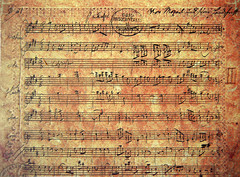Far more than the "technique of finance and the technique of construction" lifted the formal and material limitations of architecture, the technique of digital representation lifts the material and formal constraints on music. One could compose music today by entering a series of hexadecimal characters. Or at least, so one might conclude from the fact that a digital recording of a musical performance is nothing else but a long, algorithmic concatenation of answers to positive yes-or-no questions (i.e., a series of 1's and 0's). If we can reproduce musical performances in this way, why not produce them digitally to begin with? (Here I'm not talking about "digital instruments" like the keyboard or the drumitar, with palpable spatio-temporal interfaces--just typing characters into a computer).
The temptation is to think that one only needs to accomplish a more complete synopsis of the possibilities of sound, and then freely achieve perfect forms of music without regard to any limitations. Well, why not? Is it so different from composing? Doesn't a composer put the tune he hears in his head down on paper according to a standard, completely interpretable notation?
Unlike a software engineer, a composer does not presuppose any algorithmic 'mode of projection' on the part of the executor of his notations. True: the musical notations do to some extent describe a series of sounds with a determinate pitch, volume, duration, and sequence. Yet such a series is not yet a tune. It is merely what the listener has to take no notice of in order to hear the tune. (As soon as you start focusing intently on the tones in a tune and trying to add up the positive features of sound, you stop hearing the tune.)


No comments:
Post a Comment